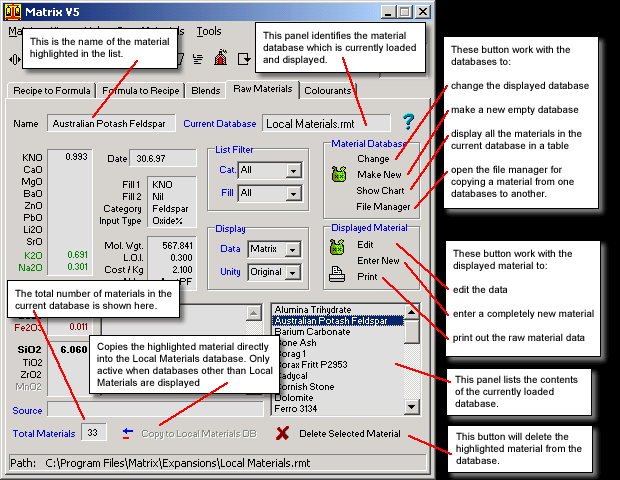|
Recipes are lists
of raw materials and their quantities.
When a recipe
is fired the raw materials break down and contribute certain oxides
to the melt. The proportions of these oxides to one another in part
determines the characteristics of the resultant glaze.
A recipe of
raw materials may be represented in a form which lists the proportions
of oxides in the fired glaze. This listing is called the unity formula.
Matrix can calculate
the unity formula for a glaze but in order to do this it needs to
know what oxides may be contributed by the raw materials in the
recipe. An analysis for any raw material may be obtained from the
supplier or from a laboratory equiped for the task.
Matrix has a
number of raw material databases which store the oxide analyses
of over 700 materials. All the calculations done by Matrix are based
on the information in these databases.
In
the Raw Materials environment:
- new materials
may be entered into one or more databases.
- a material
in a databases may be edited.
- materials
may be deleted from a database.
- materials
may be moved or copied from one databases to another.
- a material
database may be displayed in chart (table) form assisting comparisons.
- new databases
may be created
The
Importance of Accurate Raw Material Data
Naturally the
relevance of formula information calculated by Matrix is dependant
on the validity of the material data in it's databases. In the cases
of mined materials which might change over time as the mining location
changes, it is sometimes difficult to ensure that what you purchase
is accurately represented by the material analysis which you have
in your databases.
The maintenance
of your raw material databases is your responsibility. It is wise
from time to time to seek current analysis for the materials you
commonly use. If the analysis has changed it should be entered as
a new material e.g. a new analysis for Microwhite Clay could
be entered as a new material with the name Microwhite Clay 2001.
This preserves the capacity to reformulate an old glaze which used
the old Microwhite Clay with Microwhite Clay 2001.
Sometimes the
changes are not significant and need not be of concern. Some producers
of materials such as feldspars constantly analyze their materials
and adjust them by blending in other materials so that the material
analysis is kept constant.

Fig.1
The Raw Materials environment. |
Raw
Material Environment Functions
Fig.1 shows
the Raw Materials environment which may be accessed by clicking
the Raw Materials tab.
The default
raw material database accessed when booting Matrix for the first
time, is Local Materials.rmt. All raw materials databases
are kept in the Raw Materials folder.
When you move
over to the Raw Materials environment the database listed is the
Local Materials database.
The various
panels display data for the highlighted raw material depending on
the settings of the List Filters and the Display Filters.
There are buttons
for various tasks that can be performed on the displayed material.
Other buttons
perfom functions aimed at the databases themselves.
All
Working Environments are Independant of One Another
Work can be
done in the Raw Materials environment without affecting work being
done in other environments. If for example you are entering a recipe
in a Recipe to Formula panel and find you do not have a material
in your databases that you need you may move over to the Raw Materials
environment, enter the material then move back to your recipe entry
and continue with the process.
Follow
these links for more information about:
|

